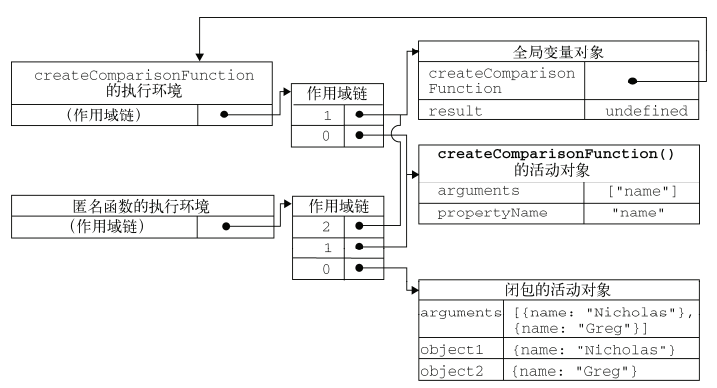<span style="font-size:18px;">function createComparisonFunction(propertyName) {
return function (object1, object2) {
var value1 = object1[propertyName];
var value2 = object2[propertyName];
if (value1 < value2) {
return -1;
} else if (value1 > value2) {
return 1;
} else {
return 0;
}
};
}
//创建函数
var compareNames = createComparisonFunction("name");
//调用函数
var result = compareNames({ name: "Nicholas" }, { name: "Greg" });
//解除对匿名函数的引用(以便释放内存)
compareNames = null;</span>作用域
<span style="font-size:18px;">// 一、定义函数的方式
// 1、函数声明
// 函数声明,它有重要特征就是函数声明提升(function declaration hoisting),
// 即在执行代码之前会先读取函数声明。这就意味着可以把函数声明放在调用它的语句后面。
function funcName(arg1, arg2) {
}
console.info(funcName.name);
// 2、函数表达式
// 这种情况下创建的函数叫做匿名函数(anonymous function),匿名函数有时候也叫拉姆达函数。
var funcName = function(arg1, arg2) {
};
var sayWords;
var condition = false;
if (condition) {
sayWords = function() {
console.info("hello");
}
} else {
sayWords = function() {
console.info("world");
}
}
// 二、将函数作为其他函数的值返回
function createComparisonFunction(propertyName) {
return function (object1, object2) {
var value1 = object1[propertyName];
var value2 = object2[propertyName];
if (value1 < value2) {
return -1;
} else if (value1 > value2) {
return 1;
} else {
return 0;
}
};
}
var people = [];
for (var i = 0; i < 5; i++) {
var person = new Object();
person.age = (i-2) * (i-2) - 3;
person.name = "Jack";
people.push(person);
}
people.sort(createComparisonFunction("age"));
console.info(people);
// 三、递归
function factorial(num) {
if (num <= 1) {
return 1;
} else {
return num * factorial(num - 1);
}
}
console.info("factorial(5):" + factorial(5));
var anotherFactorial = factorial;
factorial = null;
alert(anotherFactorial(4)); // 出错
// arguments.callee 是一个指向正在执行的函数的指针
// 在严格模式下,不能通过脚本访问arguments.callee
function factorial(num) {
if (num <= 1) {
return 1;
} else {
return num * arguments.callee(num - 1);
}
}
// 使用命名函数表达式
var factorial = (function f(num) {
if (num <= 1) {
return 1;
} else {
return num * f(num - 1);
}
});
// 四、闭包
// 闭包是指有权访问另一个函数作用域中的变量的函数。
// 由于闭包会携带包含它的函数的作用域,因此会比其他函数占用更多的内存。
// 4.1、闭包与变量
function createFuncs() {
var result = new Array();
for (var i = 0; i < 10; i++) {
result[i] = function() {
return i;
};
}
return result;
}
// 闭包副作用,即闭包只能取得包含函数中任何变量的最后一个值。
var funcs = createFuncs();
for (var i = 0; i < funcs.length; i++) {
console.info(funcs[i]());
}
function createFuncs1(){
var result = new Array();
for (var i=0; i < 10; i++) {
result[i] = function(num) {
return function() {
return num;
};
}(i);
}
return result;
}
var funcs = createFuncs1();
for (var i = 0; i < funcs.length; i++) {
console.info(typeof funcs[i]);
console.info(funcs[i]());
}
// 4.2 this对象
// this对象是在运行时基于函数的执行环境绑定的:在全局函数中,this等于window,
// 而当函数被作为某个对象的方法调用时,this等于那个对象。
// 不过,匿名函数的执行环境具有全局性,因此其this对象通常指向window。
// 每个函数在被调用时都会自动取得两个特殊变量:this和arguments。
// 内部函数在搜索这两个变量时,只会搜索到其活动对象为止,
// 因此永远不可能直接访问外部函数中的这两个变量。
var name = "The Window";
var object = {
name: "My Object",
getNameFunc: function(){
return function(){
return this.name;
};
}
};
console.info(object.getNameFunc()()); // "The Window"(在非严格模式下)
var object = {
name: "My object",
getNameFunc: function() {
var that = this;
return function() {
return that.name;
}
}
}
console.info(object.getNameFunc()()); // "My Object"
// 4.3 内存泄露
function assignHandler(){
var element = document.getElementById("someElement");
element.onclick = function() {
alert(element.id);
};
}
function assignHandler(){
var element = document.getElementById("someElement");
var id = element.id;
element.onclick = function(){
alert(id);
};
element = null;
}
// 五、模仿块级作用域
function outputNumbers(array, count) {
for (var i = 0; i < count; i++) {
console.info(array[i]);
}
console.info("i = ", i); // i = 5
}
var arr = [1, 4, 6, 3, 7];
outputNumbers(arr, arr.length);
function outputNumbers1(array, count) {
for (var i = 0; i < count; i++) {
console.info(array[i]);
}
var i; // 忽视该声明
console.info("i = ", i); // i = 5
}
outputNumbers1(arr, arr.length);
// JavaScript 没有块级作用域的概念,匿名函数可以用来模仿块级作用域。
(function(){
// 这里是块级作用域
})();
function outputNumbers(array, count) {
(function () {
for (var i = 0; i < count; i++) {
console.info(array[i]);
}
})();
console.info("i = ", i); //导致一个错误!
}
(function() {
var now = new Date();
if (now.getMonth() == 0 && now.getDate() == 1) {
console.info("Happy new year!");
}
})();
// 六、私有变量
// JavaScript中没有私有成员的概念;所有对象属性都是公有的。但有私有变量的概念。
// 任何在函数中定义的变量,都可以认为是私有变量。
// 私有变量包括函数的参数、局部变量和在函数内部定义的其他函数。
// 权访问私有变量和私有函数的公有方法称为特权方法(privileged method)。
// 利用闭包的作用域
// 1、实例变量
function MyObject() {
// 私有变量和私有函数
var privateVariable = 10;
function privateFunction() {
return false;
}
// 特权方法
this.publicMethod = function () {
privateVariable++;
return privateFunction();
};
}
function Person(name){
this.getName = function(){
return name;
};
this.setName = function (value) {
name = value;
};
}
var person = new Person("hello");
console.info(person.getName()); // "hello"
person.setName("world");
console.info(person.getName()); // "world"
// 2、静态私有变量
(function(){
// 私有变量和私有函数
var privateVariable = 10;
function privateFunction(){
return false;
}
// 构造函数
MyObject = function(){
};
// 公有/特权方法
MyObject.prototype.publicMethod = function(){
privateVariable++;
return privateFunction();
};
})();
(function(){
var name = "";
Person = function(value){
name = value;
};
Person.prototype.getName = function(){
return name;
};
Person.prototype.setName = function (value){
name = value;
};
})();
var person1 = new Person("All");
console.info(person1.getName()); //"All"
person1.setName("is");
console.info(person1.getName()); //"is"
var person2 = new Person("well");
console.info(person1.getName()); //"well"
console.info(person2.getName()); //"well"
// 3、模块模式
// 通常JavaScript是以对象字面量的方式来创建单例对象的
var singleton = {
name : value,
method : function () {
//这里是方法的代码
}
};
// 模块模式通过为单例添加私有变量和特权方法能够使其得到增强。
// 如果必须创建一个对象并以某些数据对其进行初始化,同时还要公开一些能够访问这些私有
// 数据的方法,那么就可以使用模块模式。
var singleton = function() {
// 私有变量和私有函数
var privateVariable = 10;
function privateFunction() {
return false;
}
//特权/公有方法和属性
return {
publicProperty: true,
publicMethod : function() {
privateVariable++;
return privateFunction();
}
};
}();
var application = function() {
//私有变量和函数
var components = new Array();
//初始化
components.push(new BaseComponent());
//公共
return {
getComponentCount : function() {
return components.length;
},
registerComponent : function(component) {
if (typeof component == "object") {
components.push(component);
}
}
};
}();
1、增强的模块类型
// 对某种类型的实例进行加强
var singleton = function(){
//私有变量和私有函数
var privateVariable = 10;
function privateFunction(){
return false;
}
//创建对象
var object = new CustomType();
//添加特权/公有属性和方法
object.publicProperty = true;
object.publicMethod = function(){
privateVariable++;
return privateFunction();
};
//返回这个对象
return object;
}();
var application = function(){
//私有变量和函数
var components = new Array();
//初始化
components.push(new BaseComponent());
//创建application的一个局部副本
var app = new BaseComponent();
//公共接口
app.getComponentCount = function() {
return components.length;
};
app.registerComponent = function(component) {
if (typeof component == "object") {
components.push(component);
}
};
//返回这个副本
return app;
}();
//有点像C#泛型中对类型参数的约束
internal class Base {
public virtual void M<T1, T2>()
where T1 : struct
where T2 : class {
}
}</span>1、当在函数内部定义了其他函数时,就创建了闭包。闭包有权访问包含函数内部的所有变量。
(在后台执行环境中,闭包的作用域链包含着它自己的作用域、包含函数的作用域和全局作用域。)
2、闭包可以在JavaScript中模仿块级作用域
创建并立即调用一个函数,这样既可以执行其中的代码,又不会在内存中留下对该函数的引用。
3、闭包可以用于在对象中创建私有变量
即使JavaScript中没有正式的私有对象属性的概念,但可以使用闭包来实现公有方法,而通过公有方法可以访问在包含作用域中定义的变量。有权访问私有变量的公有方法叫做特权方法(privileged method)。
内容主要摘自《JavaScript高级程序设计》























 770
770

 被折叠的 条评论
为什么被折叠?
被折叠的 条评论
为什么被折叠?








